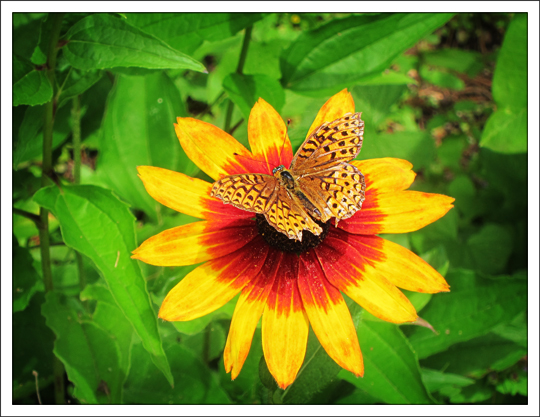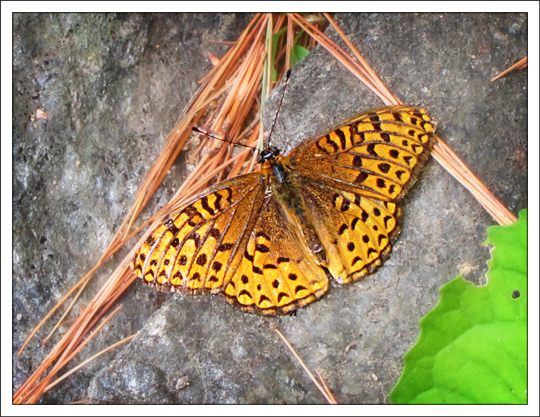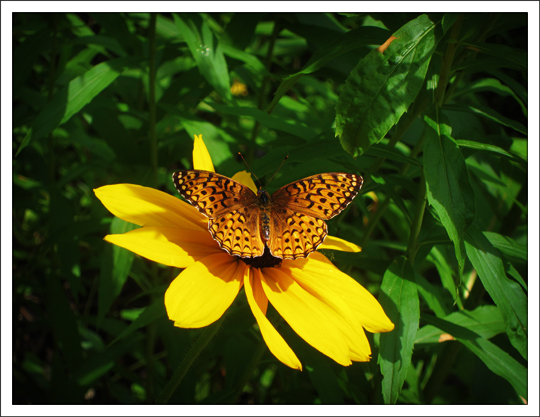Butterflies of the Adirondack Mountains:
Aphrodite Fritillary (Speyeria aphrodite)
 Butterflies of the Adirondacks: Aphrodite Fritillary in the Paul Smiths VIC Butterfly House (28 July 2012)
Butterflies of the Adirondacks: Aphrodite Fritillary in the Paul Smiths VIC Butterfly House (28 July 2012)
The Aphrodite Fritillary (Speyeria aphrodite) is an orange butterfly with many black dots and lines which may be seen in the Adirondack Mountains of upstate New York in summer. This butterfly was named after Aphrodite, the ancient Greek goddess of love, beauty, and fertility. [1] [2]
The appearance of the Aphrodite is geographically variable, which can make identification difficult. [3] [4] [5] The average wingspan of the Aphrodite Fritillary is 2.7 inches. [6] From above, the fore wing veins are lightly scaled with brown and there is generally a black dot near the fore wing base above the hind edge. [7] [8] [9] From below, the Aphrodite Fritillary's hind wing is cinnamon to chocolate-brown with silver spots. [10]
The Aphrodite is easily confused with both the Great Spangled Fritillary and the Atlantis Fritillary. [11] [12] The Great Spangled Fritillary is somewhat larger [13] and lacks the black dot near the lower fore wing base. [14] [15] The fore wing upper margins of the Aphrodite are not solid black and the submarginal pale band on the hind wing underside is quite narrow or missing. [16] [17] [18]
 Butterflies of the Adirondacks: Aphrodite Fritillary in the Paul Smiths VIC Butterfly House (18 July 2012)
Butterflies of the Adirondacks: Aphrodite Fritillary in the Paul Smiths VIC Butterfly House (18 July 2012)
The Aphrodite has a wide tolerance of different habitats. [19] [20] It may be found in wooded areas, open deciduous woods or coniferous woodlands, and prairie meadows. [21] [22] It is fairly common across northern North America from the Rockies eastward. Its range include British Columbia east to Nova Scotia and south to east Arizona, Nebraska, and northern Georgia. [23]
Male Aphrodites patrol for receptive females during the warmer hours of the day. [24] [25] Females walk about on the ground to lay single eggs near violets. [26] [27] First-stage caterpillars do not feed, but overwinter until spring, when they eat young leaves of violets. [28] [29] Caterpillar hosts include various violet species. [30] Adult Aphrodites consume nectar from thistles, rabbit brush, dog bane and other flowers. [31] Active nectaring takes place in the early morning and the late afternoon. [32]
 Butterflies of the Adirondacks: Aphrodite Fritillary in the Paul Smiths VIC Butterfly House (18 July 2012)
Butterflies of the Adirondacks: Aphrodite Fritillary in the Paul Smiths VIC Butterfly House (18 July 2012)
The flight period for Aphrodite Fritillaries in the New York City area of New York State is from late June through early September, but these butterflies have not been commonly seen there. [33] [34] They are apparently more common in Canada, usually flying in the months of July and August. [35] [36] Although the Aphrodite's flight period in the Adirondack Park has not been established, in 2012, a few Aphrodite Fritillaries were present in the Paul Smiths VIC Native Species Butterfly House and in the adjacent Butterfly Garden in late June, July, and August. [37] The appearance of our Aphrodites may differ somewhat from the descriptions in general treatments of this butterfly, reflecting its geographical variability. [38]
References
- Susan Grimm Hanley. Interpretive Naturalist, Paul Smith's College Native Species Butterfly House. Species Logbooks.
- Butterflies and Moths of North American. Species Profiles. Confirmed sightings: 7/18/12; 7/18/12; 7/19/12; 7/28/12; 8/8/12; 8/20/12
- Government of Canada. Canadian Biodiversity Information Facility. SpeciesBank
- Massachusetts Butterfly Club. Massachusetts Butterfly Species List.
- ENature. Field Guides.
- Iowa State University. Department of Entomology. BugGuide.
- World Field Guide. Speyeria aphrodite.
- University of Alberta. Department of Biological Sciences. E.H. Strickland Entomological Museum. Speyeria aphrodite.
- Ross A. Layberry, Peter W. Hall, and J. Donald Lafontaine. The Butterflies of Canada (University of Toronto Press, 1998), pp. 168-169, Plate 12.
- National Audubon Society. Field Guide to Butterflies (New York: Alfred A. Knopf, 1981), pp. 546-547.
- Jim P. Brock and Kenn Kaufman. Kaufman Field Guide to Butterflies of North America (Houghton Mifflin, 2003), pp.166-167.
- Paul A. Opler. A Field Guide to Eastern Butterflies (The Peterson Field Guide Series, Houghton Mifflin Company, 1992,1998), pp. 82-83, 238-239.
- James A. Scott. The Butterflies of North America. A Natural History and Field Guide (Stanford University Press, 1986), pp. 324-325.
- Jeffrey Glassberg. Butterflies through Binoculars. The East. A Field Guide to the Butterflies of Eastern North America (Oxford University Press, 1999), p. 104, Plate 28.
- Paul A. Opler and George O. Krizek. Butterflies East of the Great Plains: An Illustrated Natural History (The Johns Hopkins University Press, 1984), pp. 133-134, Plate 22 .
- Rick Cech and Guy Tudor. Butterflies of the East Coast. An Observer's Guide (Princeton University Press, 2005), p.164.
- Thomas J. Allen, Jim P. Brock, and Jeffrey Glassberg. Caterpillars in the Field and Garden. A Field Guide to the Butterfly Caterpillars of North America (Oxford University Press, 2005), pp. 89-90.
- Jeffrey Glassberg. Butterflies through Binoculars. A Field Guide to the Butterflies in the Boston-New York-Washington Region (Oxford University Press, 1993), p. 54, Plate 13.
